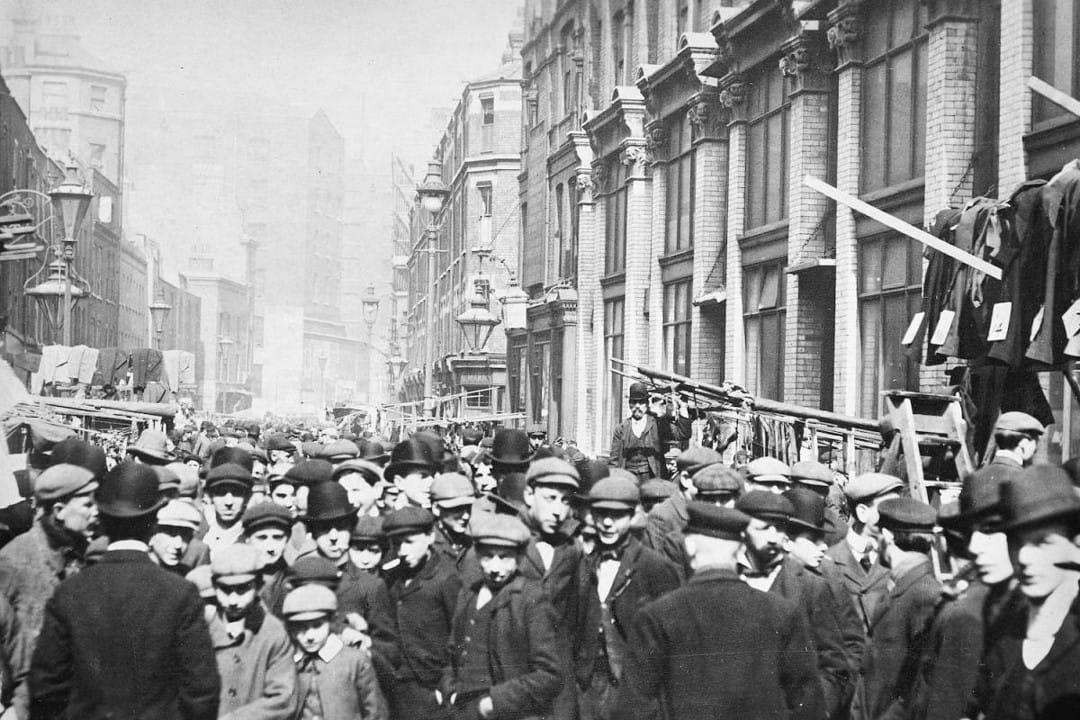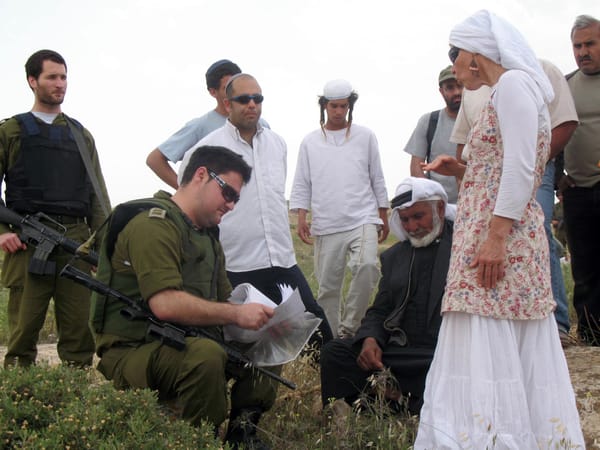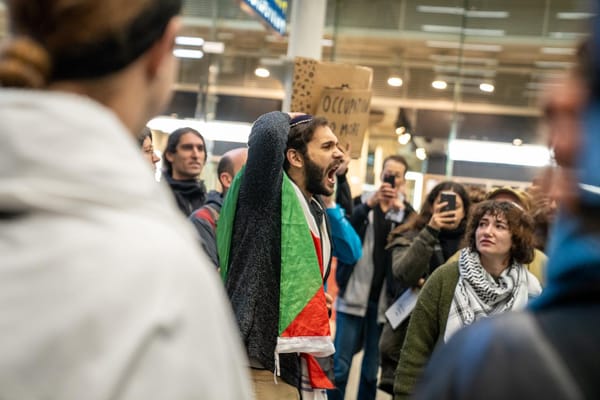The fall and rise of London's Yiddish scene
After decades of decline, the once thriving culture is bouncing back.

If you were to find yourself walking past 29 Rue du Château d’Eau in the centre of Paris, you might not realise that you were passing the largest Yiddish library in Europe. The Paris Yiddish Center–Medem Library has a small, set-back door, no mezuzah (it was founded by communists), and a simple white and silver sign, with a sheet of paper displaying its opening hours. Yet inside is one of the most active and vibrant Yiddish-speaking spaces on the continent.
I had the privilege of studying there for one term earlier this year, as an immersion student. It’s possibly the only place in the world where you can take advanced Yiddish classes four days per week throughout the year, and a rare non-Haredi space where you can speak Yiddish with people almost every day (it’s open on Saturdays but closed Fridays). My Yiddish improved by leaps and bounds after studying there for five months, immersing myself not only in the language but also the heymish community that surrounds it.
In addition to housing more than 20,000 Yiddish books, documents and recordings, the Paris Yiddish Center runs 15 weekly language classes at five different levels, a varied programme of cultural events, a theatre troupe, a choir, an informal cafe, a bookshop, Sunday school for children, lectures, literary seminars, conversation groups and summer intensives. But the heart and soul of the place is the library – whose stacks fill the basement – and the sky-lit reading room. There are books everywhere: for sale on tables and on the bookshelves lining the walls, displayed around the perimeter of the reading room, piled up in spare offices, and in boxes in the basement.

Though France is home to the world’s third-largest Jewish community, only a minority of French Jews today have Yiddish-speaking heritage – a result of both the Holocaust and the large-scale migration of north African Jews to France amid decolonisation in the 1950s and 60s. Given that the UK’s Jewish population is, by contrast, Ashkenazi-dominated, several Parisians remarked to me while I was studying there: “Surely there must be a Yiddish centre in London as well?”
When I responded that, actually, there isn’t one, they would inevitably ask in puzzlement: “Why?”
A flourishing pre-war culture
Yiddish arrived in London with the more than 100,000 eastern European Jews who migrated here from the late-19th century onwards, fleeing pogroms. Many of them settled in the East End, which was near the docklands where their ships arrived and had been a haven for new immigrant communities since the Huguenots came over from France in the 17th century.
Soon enough, Yiddish became a common language on the streets; at one stage, more than 95% of the residents of Petticoat Lane were Jews. The community established Yiddish theatres, cafes, music halls, trade unions, newspapers, book publishers, cinemas, bookshops, restaurants and more.
At the same time, Yiddish-speaking immigrants experienced pressures to assimilate and “anglicise”. This included taking on English as their everyday language.
At the Jews’ Free School (JFS, now the Jewish Free School) – which was then located in the East End – students were banned from speaking Yiddish to the point of being beaten if they did so. They were even encouraged not to speak Yiddish at home with their parents, as London historian and Yiddishist Vivi Lachs writes in her new book London Yiddishtown. David Rosenberg, an educator, tour guide and author of Battle for the East End and Rebel Footprints, adds that the headmaster at that time told the students “not to speak, think or dream in Yiddish. How do you stop dreaming in Yiddish?”
“The process of anglicisation was very strong in England,” Lachs explains. “We lost Yiddish as a language one generation earlier than in America, Argentina, Australia and South Africa.” Yet despite these pressures, the secular Yiddish-speaking community in London continued to thrive up until the middle of the century – even without being centralised.
“What’s interesting to me is that if we look at Melbourne, very early in the 20th century they created a Yiddish centre, and [the community] developed from that moment onwards,” explains Helen Beer, a former lecturer in Yiddish at UCL who was raised a native Yiddish speaker in Melbourne and has taught the language internationally for decades. The Yiddish-speaking communities in Paris and Buenos Aires, she continues, developed in much the same way: “Things were more centralised.”

In contrast, the East End of the early 20th century was home to not one but several Yiddish institutions. First, there was the Ben Uri Art and Literature Society, founded in 1915 in Whitechapel as a space to support Jewish immigrant artists and art. It moved to the West End in 1933, and is now located in St John’s Wood.
Then, in 1924, Der arbiter ring (The Workers’ Circle) opened Circle House on Great Alie Street, with 17 additional branches across Britain. Circle House had a Yiddish library, children’s Sunday school, meetings, lectures, classes, drama and singing groups, and cultural events. By 1935, it had a membership of more than 2,700 people.
In 1943, the Association of Jewish Journalists and Authors opened Folk House on Adler Street, with similar amenities and activities to Circle House. There were also lively weekly literary gatherings in Whitechapel, known as Shtensls shabes-mitogs (Stencl’s Sabbath Afternoons), regularly attended by more than 100 people by wartime. This staple of the London Yiddish community, run by Di fraynt fun yidish loshn (Friends of the Yiddish Language), endured for decades until closing its doors in 2011.
Added to this were Der Yidisher kultur-gezelshaft (Yiddish Culture Association), founded in 1938; the Ohel Club, for Polish-Jewish writers and artists in London; and as many as seven Yiddish theatres.
Yet with the exception of the Ben Uri Gallery & Museum (previously the Ben Uri Art and Literature Society), none of these institutions from the East End still exist. So how do we account for this loss?
Decline and resurgence
Undoubtedly, the second world war and the Blitz dealt a major blow to London’s Yiddish scene. Some spaces were destroyed or damaged, including Circle House.
In London Yiddishtown, Lachs describes the impact of the war and the Holocaust on London’s Jewish community: “Many of the older community activists had died; Jews had moved out of the East End, dispersing into other areas of London, and the community that remained was in decline. It was a community in shock.”
London was not exceptional in this regard. Nick Underwood, author of Yiddish Paris, tells me: “To some extent it’s a postwar phenomenon that happens in a lot of cities that have [newly arrived] Yiddish-speaking households. New York is an example – they shed the alter heym [the old home] and adopt the language of their new spaces.”
Then, with the creation of the state of Israel in 1948, Zionism became a strong force in the Jewish community. Yiddish came to be seen by some Jews as a “lower-class” language associated with ghettos and concentration camps, whereas Hebrew was associated with modernity and strength. To some extent, this attitude endured throughout the 20th century.
“Yiddish at that time was derided in the Anglo-Jewish community because of Zionism [and] because of class politics,” says Rosenberg. “It was put down, or it was seen as promoting the language of the diaspora, and the diaspora inevitably leads to the Holocaust.”

Rosenberg is optimistic, however, that the decline in Yiddish may be reversing. “I think what’s happened in the last 20 years or so in London is significant, with the rise of groups like Jewdas, who are very keen on Yiddish, and people like Daniel Kahn. To me, that kind of identification with Yiddish is much stronger than anything that there was for quite a while before that.”
Both he and Lachs see the creation of the summer courses Ot Azoy, KlezFest and Golden Peacock, run by the Jewish Music Institute at SOAS since the early 2000s, as an important turning point. “That opened a new chapter of Yiddish in London,” says Lachs.
Though smaller in number than a century ago, the Yiddish community in London remains active. Lachs and Steve Ogin run the monthly Yiddish Open Mic Cafe at JW3 (and sometimes on Zoom) – a participatory “jamboree” of songs, poems, jokes, stories and games; founded in 2018, it is in many ways the descendant of the Sabbath Afternoon salons. There are also weekly language classes (of which I teach two), an annual immersive sof-vokh (weekend), the social group Yidishe shtub (Yiddish House) and The Great Yiddish Parade.
The Yiddish community in London remains, in many ways, decentralised – its own kind of diaspora. Will we one day come together in one central space, like in Paris, Boston or Melbourne? Do we need to?▼
Tamara Micner is an award-winning performer and writer for theatre, an artist wellbeing and access support worker, and a Yiddish teacher with Babel’s Blessing.




